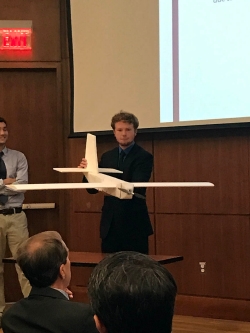Mechanical Engineering Students Pursue Real-World Design Projects

In fall 2018, Mike Simard, PE, joined Villanova’s College of Engineering as professor of the practice in the Department of Mechanical Engineering. In this role, Simard is responsible for the department’s senior capstone design course. In addition to lecturing, coordinating the program and advising many of the student project teams, he also is involved in recruiting new industry partners. Recently, he and the students were successful in winning four $600 project grants through the Philadelphia Section of the American Society of Mechanical Engineers.
“ASME Philadelphia has a program through which they award funding for student projects. Villanova submitted five proposals and was successful in winning grants for four of them,” says Simard. The winning proposals were for the following:
- Design-Build-Fly (Team members: Cole Chebi, Nolan Lauber, Tyler Meluch, Neal Peng and Eric Robinson): Since 1997, the American Institute of Aeronautics and Astronautics (AIAA) foundation has sponsored the Design-Build-Fly competition in which student teams must design, fabricate and demonstrate the flight capabilities of an unmanned, electric powered, radio-controlled aircraft, which can best meet a specified mission profile. The competition provides a real-world aircraft design experience for engineering students. This year’s project is to design and build a versatile aircraft that will be the basis for a recurring Villanova team that will compete annually in the AIAA competition.
- Affordable 6" PVC Pipe Connection Method (Team members: Liz Hagerty, Peter Herlihey, Adrienne Jacob, Andrew Lee and Katy Reteneller): In rural Panama, PVC pipes have been obtained by one of Villanova’s missionary partners to expand an existing gravity-driven water system, but joining the pipes has been problematic as couplings are cost prohibitive. The goal is to design a reliable, cost-effective method to permanently join these pipes to enable the expansion of the 15,000-member community’s water system.
- Water Quality Monitoring in Madagascar (Team members: Thad Cullina, Lindsay Devereaux, Bridget Mullen and Harrison Paige): In Southern Madagascar, communities have access to water through a decentralized network of remotely located water collection tanks. In a previous project, a remote level monitoring system was designed and installed to allow locals to receive text messages when tank levels were too low or high. This year’s project builds on the remote-monitoring infrastructure, and includes designing low-cost water quality monitoring, specifically turbidity, conductivity and chlorine levels.
- Thermal Interface Material Tester (Team members: Drew Dallman, Matt LaRose, John Lockhart and Yannis Nyktas): Thermal interface materials (TIMs), when used in electronic packaging, seek to greatly increase heat flow through components in computers or other electronic equipment. To characterize the thermal performance of these materials, a TIM Tester is being designed and built that can accurately measure thermal resistance of both elastomeric pads and pastes. This instrument will allow Villanova researchers to collaborate with industry on a number of development projects.
Through the efforts of Simard, Department Chair Dr. Sridhar Santhanam and Assistant Dean of External Relations Keith Argue, Mechanical Engineering seniors have been given a variety of capstone options this year, ranging from industry and service projects, to those inspired by faculty and students. Current projects include:
- At Sea Landing System for Drones—Harris Corporation
- Slab Anchor Grid System for Building Piping—JB&B
- Regulating Variable-Air-Volume Valves for HVAC Systems—Turner Construction Company
- Leg Exoskelton—Dr. Hashem Ashrafiuon, sponsored by PRIME Technologies
- Cambodia Unexploded Ordnance Mechanical De-armer —Golden West Humanitarian Foundation
- Integrated STEM Education Robot—Academy of Natural Science
- Design of a Miniature Autonomous Surface Vessel—Dr. Hashem Ashrafiuon
- Structural Analysis and Design of Formula SAE Chassis Components—Formula SAE team
Argue says, “We’ve been very successful in providing students with projects that meet their areas of concentration and interest. I look forward to working with Mike in the coming year to further expand the number of corporate partners in the program.”
